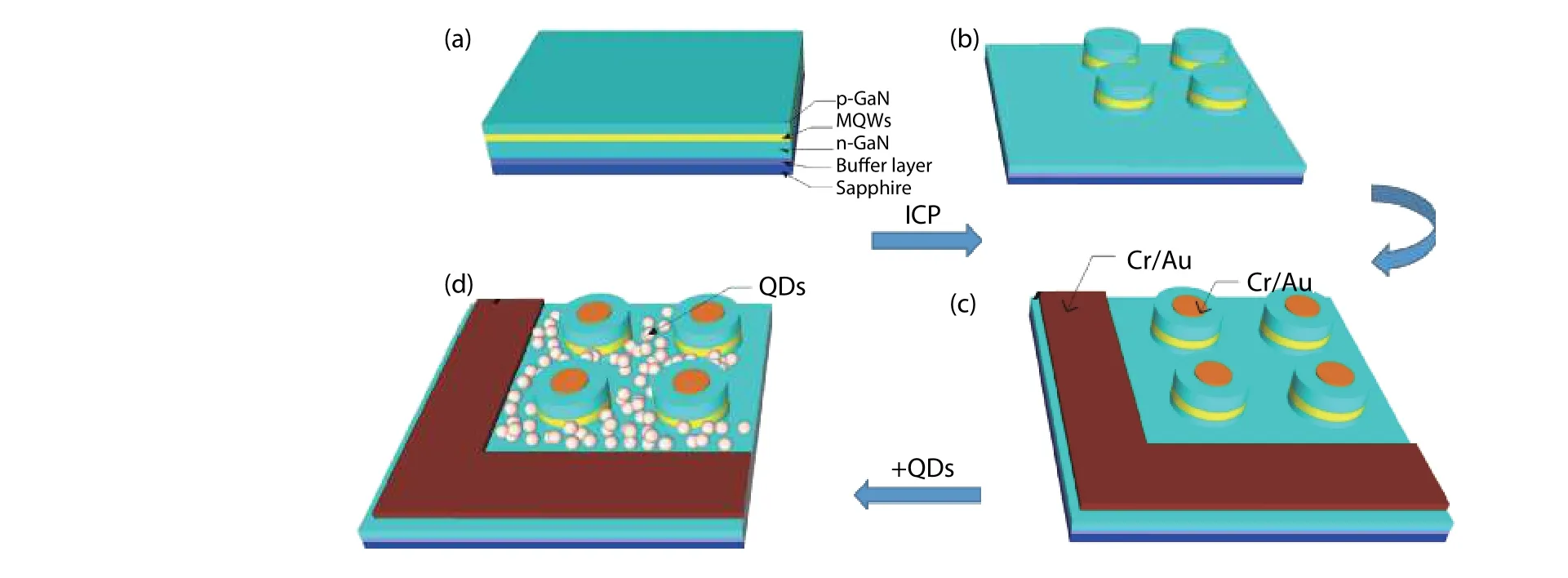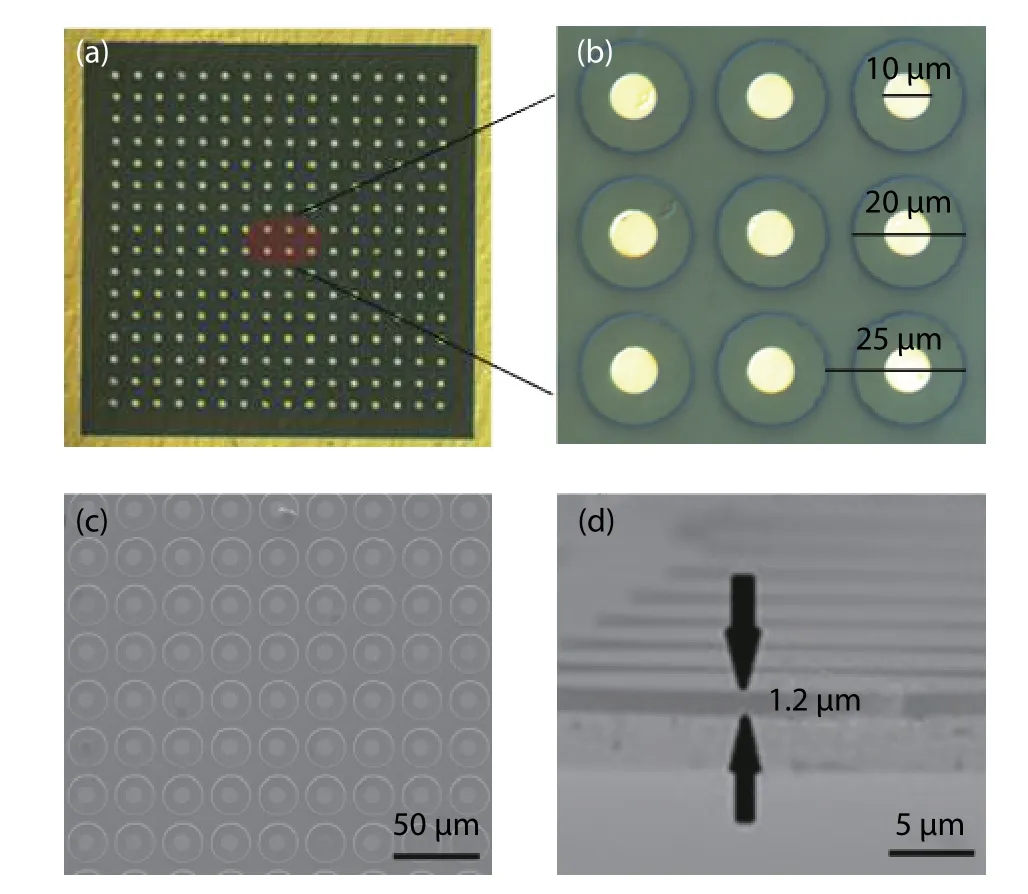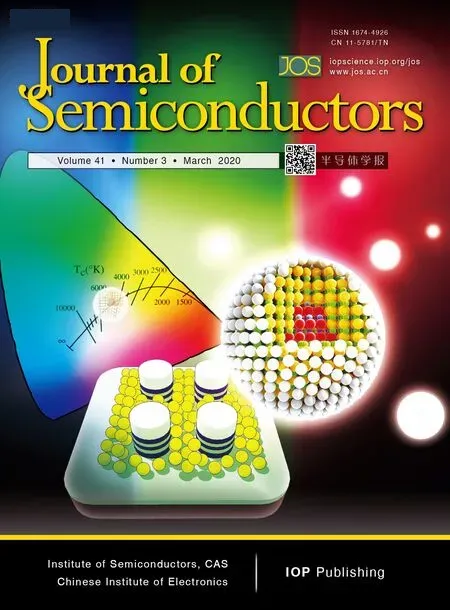High performance GaN-based hybrid white micro-LEDs integrated with quantum-dots
2020-03-16FeifanXuXuCenBinLiuDanbeiWangTaoTaoTingZhiQiWangZiliXieYugangZhouYoudouZhengandRongZhangKeyLaboratoryofAdvancedPhotonicandElectronicMaterialsSchoolofElectronicScienceandEngineeringNanjingUniversityNanjing100China
Feifan Xu , Xu Cen , Bin Liu , , Danbei Wang , Tao Tao , Ting Zhi, Qi Wang , Zili Xie ,Yugang Zhou , Youdou Zheng , and Rong Zhang , Key Laboratory of Advanced Photonic and Electronic Materials, School of Electronic Science and Engineering, Nanjing University, Nanjing 100, China
2Nanjing National Laboratory of Microstructures, Nanjing University, Nanjing 210023, China
3College of Electronic and Optical Engineering & College of Microelectronics, Nanjing University of Posts and Telecommunications, Nanjing 210023, China
4Xiamen University, Xiamen 316005, China
Abstract: Hybrid white micro-pillar structure light emitting diodes (LEDs) have been manufacture utilizing blue micro-LEDs arrays integrated with 580 nm CIS ((CuInS2-ZnS)/ZnS) core/shell quantum dots. The fabricated hybrid white micro-LEDs have good electrical properties, which are manifested in relatively low turn-on voltage and reverse leakage current. High-quality hybrid white light emission has been demonstrated by the hybrid white micro-LEDs after a systemic optimization, in which the corresponding color coordinates are calculated to be (0.3303, 0.3501) and the calculated color temperature is 5596 K. This result indicates an effective way to achieve high-performance white LEDs and shows great promise in a large range of applications in the future including micro-displays, bioinstrumentation and visible light communication.
Key words: GaN; hybrid white micro-LEDs; quantum dots
1. Introduction
III-nitride materials are direct bandgap semiconductors,the bandgap crosses from the infrared to the ultraviolet spectral range[1]stimulating optoelectronic devices for many applications. As the source of light, semiconductor chips are mainly used for semiconductor solid-state lighting technology, and directly convert electric energy into light energy with a high conversion efficiency. As the core component of semiconductor light source, LEDs have the advantages of low energy consumption, long work lifetime, compact size, environmentally friendly, safe, and can work in various harsh environments[2,3].They are a new generation filled with anticipation of lighting sources behind the incandescent lamp and fluorescent lamp.GaN-based LEDs have a large range of applications in general lighting, display screens and communication, etc[4,5]. The typical size of LED chips is frequently in the millimeter scale.With the continuous developments in basic science and micro-manufacturing technology, solid-state lighting technology will replace the existing lighting technology in the future, ushering in a new era of lighting technology. Traditional white LED lighting chips use blue InGaN/GaN multiquantum wells LEDs and yellow phosphors (such as Y3Al5O12:Ge3+(YAG)) to mix with the white light[6,7]. Despite that much related research has been done in this regard, the white LEDs obtained by this method show high color temperature (CCT) and low color rendering index (CRI) due to the lack of efficient red light, which limit the applications of white LEDs in many fields[8,9].
In order to expand the applications of GaN-based LEDs to display, visible light communication, optogenetics and other advanced applications, researchers are concentrating on developing high power and luminous efficiency III-nitride LEDs[10,11]. Such high-power white LEDs have been widely used in solid-state lighting and display. However, their large size stops the development steps of high-resolution LEDs, so there is an urgent need for smaller size GaN-based LEDs[12,13].In contrast to the standard LEDs, the micro-LEDs with a luminous area of only a few tens of square microns can not only achieve high-resolution display, but also have the advantages of fast response, small energy consumption and high efficiency[14,15]. However, the development of micro-LEDs is still ongoing, and there are a number of issues to be solved, such as manufacturing process challenges, high energy conversion efficiency and integration difficulties. For example, the sidewall defect caused by dry etching leads to a large reduction in the efficiency of the chip[16]. Therefore, high efficiency,high CRI micro-LEDs have been of wide concern in recent years.
In this work, a hybrid white micro-LED array integration with inorganic quantum dots is designed and fabricated. Electrical and optical characterization of this hybrid white micro-LED array shows that the devices have a lower turn-on voltage and reverse leakage current. With the current density is increasing from 3.2 to 1114 A/cm2, and the peak of electroluminescence (EL) of the device has a small blue shift. The photoluminescence spectra (PL) of hybrid white LEDs was measured experimentally, and the calculated color temperature was 5596 K. This result indicates an effective way of achieving high-performance devices for illumination and display applications.
2. Device fabrication
The blue micro-LED array with micron-pillar structures is fabricated from planar LED wafers grown by metal organic chemical vapor deposition (MOCVD) on c-plane (0001) sapphire substrates. The epitaxial structure is shown in Fig. 1(a).Firstly, the micron-pillar array structures were formed by a standard lithography and inductively coupled plasma (ICP)etching process. By optimizing the etching conditions, we can reduce the side-wall damage caused by etching. The micron-pillars were etched through the P-type GaN layer to Ntype GaN with depth of about 1.2 μm, as shown in Fig. 1(b).For this structure, the unit of the micro-LED array has a common N-contact electrode while the P-contact electrode is independent. A 100 nm SiO2layer was developed by plasma enhanced chemical vapor deposition (PECVD) to use as a passivation layer for reducing leakage channels and protecting devices. Then the pattern of N-type and P-type electrodes are formed by photolithography and the N-type and P-type Cr/Au electrodes are fabricated by electron beam evaporation simultaneously, as shown in Fig. 1(c). The process of Ntype and P-type electrodes in one-step evaporation simplifies the processes, compared to the fabrications of N- and Pcontact metals, separately. Finally, the CIS ((CuInS2-ZnS)/ZnS)core–shell quantum dots with a luminescent peak wavelength of 580 nm dispersed in methylbenzene organic solution were spin-coated on the sample with micron-pillar arrays to fill the gaps between the micron-pillars. The sample is then placed on a hot table to evaporate the methylbenzene organic solvent to stabilize the quantum dots on the sample.By this way, we obtained the hybrid white micro-LEDs, as shown in Fig. 1(d).
For device observations, a bird’s eye view microscope image of the blue micron-pillar LED array is shown in Fig. 2(a).Each cell of the array contains 16 × 16 pixels, and each pixel is a circle with a diameter of 20 μm with a period of 25 μm,and the diameter of the P-type electrodes is 10 μm, as shown in Fig. 2(b). Figs. 2(c) and 2(d) show the scanning electron microscope (SEM) image of the blue micro-LEDs array with micron-pillar structures. It can be seen that this micro-array has good periodicity and uniform size. As shown in Fig. 2(d), the etching depth of the micron-pillar is measured as ~ 1.2 μm as designed, and the sidewalls look straight and smooth, which indicates less etching damage after optimizations.
3. Results and discussion
Firstly, the current and voltage (I–V) characteristics of the hybrid white micro-LEDs array are analyzed, and the results are shown in Fig. 3(a). It can be obtained from the I–V curve that, the turn-on voltage of the hybrid LEDs is 3.5 V and the reverse leakage current is about 5 × 10–10A (1.6 × 10–4A/cm2)when the reverse voltage is 5 V. It should be pointed out that, the turn-on voltage of hybrid white micro-LED is close to that of the standard planar LEDs, and the reverse leakage current is on a smaller magnitude. It indicates that the device has a good electrical performance[17]. Fig. 3(c) and Fig. 3(d) is the appearances of hybrid white micro-LEDs array emission at the injection current of 3.2 and 320 A/cm2, respectively. As the current density increases, it shows better white light emission.

Fig. 1. (Color online) (a) Epitaxial structure of blue LED. (b) The micron-pillar array structures after lithography and ICP etching. (c) N-type and Ptype Cr/Au electrodes are manufactured in only one step. (d) Micron-pillar structures with the CIS ((CuInS2-ZnS)/ZnS) core-shell quantum dots.

Fig. 2. (Color online) (a) Bird’s eye view microscope image of the blue micron-pillar LED array. (b) The enlarged picture of micron-pillar structures. (c) SEM image of the blue micron-pillar LED array. (d) The crosssectional view SEM image of blue micron-pillar LED array.

Fig. 3. (Color online) (a) I–V characteristics of one hybrid micro-LED. The inset is the leakage I–V curve in semi-log scale. (b) The EL spectra of the hybrid white micro-LED array at the different injection current density. (c) The picture of hybrid white micro-LED array emission at the injection current of 0.1 mA. (d) The picture of hybrid white micro-LED array emission at the injection current of 1 mA.

Fig. 4. (Color online) (a) The PL spectra of CIS quantum dots and one pixel in the hybrid white micro-LEDs array. (b) The locations of hybrid white LEDs in the CIE 1931 chromaticity diagram.
Then the room temperature electroluminescence (EL)spectra of the hybrid white micro-LED arrays were acquired when the current density increased from 3.2 to 1114 A/cm2,the results are shown in Fig. 3(b). The emission peak of blue micro-LEDs moves slightly from 476 to 472 nm as the injection current density increases, it shows great emission wavelength stability. This is mainly attributed to the decreasing of quantum confined Stark effect (QCSE), consequently, the recombination efficiency of carriers gets a great increase[11].
Finally, the room temperature photoluminescence (PL)spectra of the hybrid white micro-LEDs were obtained using a Renishaw InVia Micro-PL system. From Fig. 4(a), we can see that the peak at 478 nm corresponds to the luminescence of InGaN/GaN MQWs, and the peak at 580 nm corresponds to the luminescence of CIS quantum dots. Both the luminescence sources combine to give a mixed nearly white color,the corresponding color coordinates of which are calculated to be (0.3303, 0.3501), and the color temperature is to be 5596 K. The data points in the CIE chromaticity diagram are shown in Fig. 4(b).
4. Conclusions
In summary, the blue micro-LED array with micron-pillar structures have been fabricated using micromachining technology, and then integrated with 580 nm CIS quantum dots for white emissions and display application. The electrical properties of hybrid white micro-LEDs are manifested by I–V characteristics, which show good electrical performance. The EL spectra of the hybrid white micro-LEDs at the injection current density ranging from 3.2 to 1114 A/cm2shows that the emission peak is stable, but still has a small blue shift due to the QCSE. From the PL spectra of the hybrid white micro-LED array, better white light emission with color coordinates of(0.3303, 0.3501) and color temperature of 5596 K have been achieved. This work provides an effective way for high-performance applications of illumination and display.
Acknowledgments
We would like to thank Prof. Haizheng Zhong and his graduate students at Beijing Institute of Technology, for providing high-quality CIS quantum dots. This work is supported by National Key R&D Program of China (2016YFB0400100), National Nature Science Foundation of China (61921005, 61674076,61674081, 61605071, 61974062), Nature Science Foundation of Jiangsu Province (BY2013077, BK20141320, BE2015111),Six Talent Peaks Project of Jiangsu Province (XYDXX-081),Open Fund of the State Key Laboratory on Integrated Optoelectronics (IOSKL2017KF03), Innovation Project of Postgraduate Training in Jiangsu Province (KYCX18_0031), Fundamental Research Funds for the Central Universities(021014380096), Collaborative Innovation Center of Solid State Lighting and Energy-saving Electronics.
杂志排行
Journal of Semiconductors的其它文章
- High wall-plug efficiency 808-nm laser diodes with a power up to 30.1 W
- Simulation analysis of a high efficiency GaInP/Si multijunction solar cell
- Analysis of the time domain characteristics of tapered semiconductor lasers
- 35 km amplifier-less four-level pulse amplitude modulation signals enabled by a 23 GHz ultrabroadband directly modulated laser
- Enhancement of photocatalytic activity by femtosecond-laser induced periodic surface structures of Si
- Fabrication of flexible AlGaInP LED
